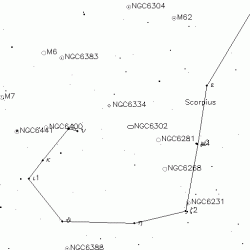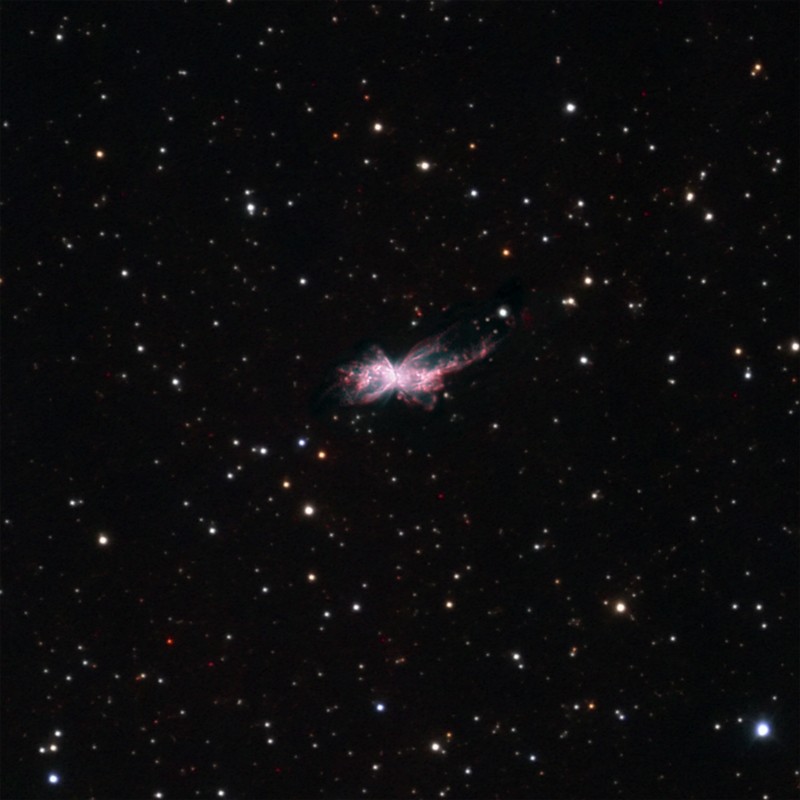Over the weeks we’ve looked at a lot of curious objects and today is no exception. NGC 6302 is often called the “Bug Nebula”, but its resemblance to an insect isn’t what makes it unique – it’s the complex structure. Deep inside this bipolar planetary nebula lay an unseen star… One of the hottest objects in the galaxy.
Residing about 4,000 light years away in the constellation of Scorpius, NGC 6302 is the end remains of an enormous dying star. With a surface temperature of an estimated 200,000 K, its central star exceeds our own Sun’s mean temperature output by nearly 35 times – yet has never been observed. Why? Because it is shielded from view at all wavelengths by an impossibly dense equatorial disc composed of gas and dust… One that may have restricted the star’s outflow into the unusual bipolar structure we can see.
But the hidden central star isn’t what’s bugging scientists, it’s the chemical composition!
Filled with ionization walls, edges and lobes, this dust is both oxygen and carbon-rich – a dual chemistry which means it has undergone recent changes and alternate formation processes in its 10,000 year life. Studies done by the European Space Agency’s Infrared Space Observatory (ISO) have shown that the dusty torus contains hydrocarbons, carbonates such as calcite, as well as water ice and iron. If the word carbonates made you raise an eyebrow, it should because carbonates form when carbon dioxide dissolves in liquid water and forms sediments.
Says Albert Zijlstra from UMIST: “What caught our interest in NGC 6302 was the mixture of minerals and crystalline ice – hailstones frozen onto small dust grains. Very few objects have such a mixed composition.”
Yet NGC 6302 is even more complex, displaying evidence that a second pair of lobes may have formed during a previous phase of the star’s mass loss. The visible northwest lobe is believed to have been created some 1,900 years ago and shows some signs that it may have once collided with pre-existing globules of gas which changed its outflow. According to studies done by Groves, Doptia, Williams and Hua; “We find that for NGC 6302, the visible to IR extinction law is indistinguishable from `standard’ interstellar reddening, but that the UV extinction curve is much steeper than normal, suggesting that more small dust grains had been ejected into the nebula by the PN central star.”
Kinematical studies done by Minkowski and Johnson suggest that NGC 6302 originated in some type of explosive event. It exhibits a rich spectrum of lines, indicating rich deposits of helium and nitrogen – far more than an ordinary planetary nebula. What the Bug Nebula seems to lack in its diet, however, is iron and calcium – two elements which may very well be tied up as solid grains.
So what’s next for this extreme, high-excitation planetary nebula? According to Wright, Barlow, Ercolano and Rauch; “We use the 3D photoionisation code to model the emission from the gas and dust. We have produced a good fit to the optical emission-line spectrum, from which we derived a density distribution for the nebula. A fit to the infrared coronal lines places strong constraints on the properties of the unseen ionising source. We find the best fit comes from using a 220,000 K hydrogen-deficient central star model atmosphere, indicating that the central star of this PN may have undergone a late thermal pulse.”
 But don’t you be late observing the Bug Nebula yourself! NGC 6302 is located in Scorpius (RA 17 13 44 Dec -37 06 15). At around magnitude 9, this surprisingly bright planetary is well within the reach of a mid-size telescope and a treat to larger aperture. NGC 6302 was discovered by James Dunlop in 1826 with a handmade reflecting telescope he had constructed himself and the earliest known study of NGC 6302 is Edward Emerson Barnard who, in 1907, drew and described it.
But don’t you be late observing the Bug Nebula yourself! NGC 6302 is located in Scorpius (RA 17 13 44 Dec -37 06 15). At around magnitude 9, this surprisingly bright planetary is well within the reach of a mid-size telescope and a treat to larger aperture. NGC 6302 was discovered by James Dunlop in 1826 with a handmade reflecting telescope he had constructed himself and the earliest known study of NGC 6302 is Edward Emerson Barnard who, in 1907, drew and described it.
Seek it out… And enjoy!
This week’s awesome image was taken by Don Goldman from Macedon Ranges Observatory.


An extremely intriguing nebula, and just around the block. 🙂
My first reaction (and made verbally) when I saw this photo was “Whoa!”
How do they know that this is the results of an explosion? Can you tell by the spectral lines (indicating what elements are possessed) that it was an explosion or is it something else?
Do the reports state the approximate total volume of all the material? Is it possible some of the material came from 1 or 2 large “earth” type planets (or planets with a lot of water with vegitation) which were caught up in the raveges of the dying star?
Hi, RL… Good question.
According to Minkowski’s observations, NGC 6302 “exhibits a wide range of excitation and ionization conditions, and is expanding in a manner suggestiong an explosive origin.” This was done at optical wavelengths. Even with photoelectric observations, it’s still not clear what’s driving the expansion “with mass motions that must yet be explained.”
As for Aodhhan’s question:
According to the work of Matsuura, Aijlstra, Molster and Waters: “The butterfly-shaped planetary nebula, NGC 6302, shows a unique, dense equatorial dark lane, which is presumably a dusty disc, obscuring an unobserved, very hot central star. We trace the structure of this disc using Hubble Space Telescope Hα and [Nii] images, Very Large Telescope L-and M-band images at 0.4-arcsec resolution, including Brα and polycyclic aromatic hydrocarbon (PAH) images, and a James Clerk Maxwell Telescope 450-μm image. Extinction maps are derived from these images. Within the disc, the extinction is AHα= 5–7 mag and ABrα= 1–2 mag . The 450-μm map shows a north–south elongated central core, tracing the massive dust disc, and extended emission from dust in the bipolar flows. A fit to the spectral energy distribution yields the disc dust mass of 0.03 M⊙ . The innermost region shows an ionized shell. The orientation of the polar axis shows a marked change between shell, disc and inner and outer outflow. The structures are well described by the warped-disc model of Icke (2003). PAH images are presented: PAH emission is found in the shell but avoids the disc. An infrared source is found close to the expected location of the central star.”
I know that’s doesn’t precisely answer your question – but the truth is, science doesn’t precisely know what’s going on either! The most recent is from Kemper, Molster, Jager and Waters:
“We have analysed the full ISO spectrum of the planetary nebula NGC 6302 in order to derive the mineralogical composition of the dust in the nebula. We use an optically thin dust model in combination with laboratory measurements of cosmic dust analogues. We find two main temperature components at about 100 and 50 K respectively, with distinctly different dust compositions. The warm component contains an important contribution from dust without strong infrared resonances. In particular the presence of small warm amorphous silicate grains can be excluded. The detection of weak PAH bands also points to a peculiar chemical composition of the dust in this oxygen-rich nebula. The cool dust component contains the bulk of the mass and shows strong emission from crystalline silicates, which contain about 10 percent of the mass. In addition, we identify the 92 μm band with the mineral calcite, and argue that the 60 μm band contains a contribution from the carbonate dolomite. We present the mass absorption coefficients of six different carbonate minerals. The geometry of the dust shell around NGC 6302 is studied with mid-infrared images obtained with TIMMI2. We argue that the cool dust component is present in a circumstellar dust torus, while the diffuse emission from the warm component originates from the lobes.”
But your suggestion sure sounds logical… 😉
I can almost imagine this image being viewed from the bridge of the original Starship Enterprise, while Spock raises an eyebrow and remarks “fascinating”.
Great photo Don!
sounds interesting
Actually it helps a lot. Although, it doesn’t give a lot of information, the fact the torus is made of interesting material compared to the core gives some hope there was something containing all these elements in the area before all heck broke loose. I like hearing there are two distinct compositions of dust as well.
What a great time to be alive!
I agree!! To me, the ultimate treat is learning about objects like NGC 6302 and when I find them in my telescope, I can sit for hours just looking at it – and the starry sky – and reflecting on what I’ve learned.
There are even nights when I will just look at a constellation and think about all the magnificent things which lay in its direction. Who needs TV? The greatest show in the cosmos is right outside… 😉